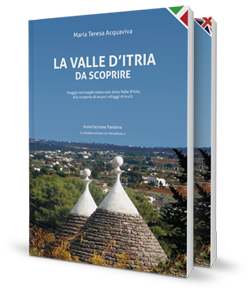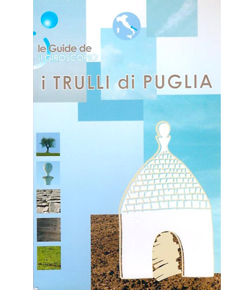Text translated by google translate.
Wherever you come from the Itria Valley, the bell tower and the dome of the Mother Church of Locorotondo stand out in the distance, like a lighthouse to attract visitors to one of the most fascinating Italian Borgo (1).
"Going down towards Taranto, the monumental church of S. Giorgio in Locorotondo, with a Greek cross inscribed, has the facade divided into three parts of which the protruding central, framed by a large rhythm of half-columns, has a neo-sixteenth century flavor". With these words Lorenzo Bartolini Salimbeni quotes the Mother Church of Locorotondo in an essay on Italian architecture dedicated to the seventeenth and eighteenth centuries, paying homage to the monument. The church dedicated to San Giorgio is in fact a beautiful neoclassical monument, built on the highest place of the hill where the city stands, with its dome and its bell tower soaring that can be admired from any place in the Valle d’Itria. Sometimes the apex of the bell tower appears in the clouds creating very suggestive visions. This beautiful temple is the last in chronological order of those that have taken place in this place and always dedicated to the patron saint Giorgio.
A bit of history
The cult of San Giorgio in Locorotondo is linked to the origins of the city. In an edict issued in 1195 by the king of Sicily Enrico VI di Svevia (the father of Frederico II) in which he listed the possessions of the Benedictine monastic fief of Santo Stefano, near Monopoli, an locum qui dicitur Rotundus was also mentioned ... et in eo ecclesiam Santi Giorgii. The reference to a rounded village with a place of worship dedicated to San Giorgio is clear. The ancient village probably already existed under previous dominations, perhaps not, with certainty we know from the edict that it existed in the twelfth century and that there was a place of worship. The local historian Angelo Convertini, who lived between the eighteenth and nineteenth centuries, mentions in his manuscripts the primitive place of worship as a rock church, adding that perhaps it was a cave already used for pagan rites. Suggestive hypothesis not fully ascertained, however. Certainly between the fourteenth and fifteenth centuries in the same place a chapel was built, always dedicated to San Giorgio. Of it we read in a document relating to a pastoral visit of 1642 made by Bishop Fabio Magnisio, little information from which however it is deduced that it was a simple chapel with a barrel room and a conversa roof, cummersa in the local dialect (gable roof in stone). Between 1578 and 1579 a new church was built which incorporated the old medieval chapel, a church with still late Gothic architecture, trinavated and with a large rectangular choir. The sculptural stone furniture was made between the sixteenth and seventeenth centuries, while remaining faithful to Renaissance styles. Much information has been obtained on the church from the writings of the various pastoral visits between the seventeenth and eighteenth centuries and from the manuscript of the local historian Angelo Convertini, who was an eyewitness to the sixteenth-century church and saw it demolished in 1790 for the construction of the last dedicated temple to San Giorgio.
In the eighteenth century it was now a necessity to give the community of Locorotondo a larger church. After a first decision to intervene on the sixteenth-century temple, which needed intervention, it was understood that it would be wiser to demolish it and build a new one. So it was. After careful analysis of several historians, in the end the authorship of the overall project is attributed to the Bari architect Giuseppe Gimma who, however, was unable to follow the work because he had another assignment as Royal Architect of the Kingdom of Naples. Then the executors of the works were the engineer from Ostuni, engineer Carlo Fasano and the master mason Donato Antelmi. The works officially began on July 19, 1790 with the demolition of the old church of which some stones were reused, while the sculptural furniture was partly placed in the new church, partly distributed in others and also dispersed in private houses, but fortunately lately almost completely traced. During the demolition under the high altar of the old church, an urn was found with the relics of Sts. Ruffino and Vittorio, now placed in an room of the hypogeum. The works lasted 35 years because they were repeatedly interrupted. The first time in 1798, when there was a slowdown due to the difficulty of buying, to demolish them, the houses relevant to the building area of the church; in 1799 the insurrectionary movements interrupted the construction site, since Locorotondo was also involved in the anti-Bourbon rebellious climate for the establishment of the Neapolitan Republic. In this climate the church under construction was unfortunately sacked with the removal of building material and equipment. The long interruption of the works also put at risk the structures built up to then due to the exposure to atmospheric agents which also made vegetation grow on the external parts, in short there was a principle of degradation. Fortunately, after several second thoughts on the initial project, in 1810 the works resumed under the direction of the Locorotondese architect Giuseppe Campanella. In 1829 the monument was completed and consecrated.
Architecture.
In a small elegant square the facade of the eighteenth-century church of San Giorgio stands out with its decidedly classic appearance. Pairs of Ionic half-columns in the lower order and Corinthian in the upper order embellish the central projecting part, on which the main portal, crowned by a decorated tympanum, the large window in the center and, finally, on the top an elegant pediment in which the tympanum is carved with the scene of Saint George who kills the dragon to save the Princess who is terrified behind her. On the side of the Princess you can recognize a typical construction spread in the city of Locorotondo, a house with a cummersa roof, perhaps a reference was wanted precisely to the place where the saint is patron. On the lateral tops of the first order are placed the lithic statues of Saint Peter on the right and of Saint Paul on the left, by an unknown author.
On the corners of the first order of the bell tower, 47 meters high, there are the statues of the Three Marie and Veronica, coming from the polyptych of the Chapel of the Pietà dismembered during the demolition of the existing sixteenth-century church. The dome, once covered with majolica tiles, riggiole, was electrocuted and damaged in 1841, therefore the riggiole were replaced by a stone covering.
The plan of the church is composite. A central plan, however, enriched by a perspective view of the longitudinal axis on which the central nave, the high altar and the choir follow one another. The dome 35 meters high and decorated with the images of the four evangelists.The aesthetics and symbolism of the Greek cross combined with the practicality of a longitudinal development, where each additional space is functional to the celebration of the rite: the assembly of the faithful, the presbytery and the choir. The whole church is surrounded by a warm atmosphere obtained by soft colors that paint the walls. From the right side of the presbytery you enter the rooms of the sacristy and the bell tower where a plaque of the old sixteenth-century church is exposed with the engraving of the date of construction. The presbytery is raised because below is the Purgatory Chapel, where you can access from a door to the right of the main altar, passing first from the Crypt.
The altars
The baroque side altars of the church, two on each side, come from the pre-existing sixteenth-century church, all marble works made in Naples in 1764 by the marble workers Lamberti, artists who worked in various places in Puglia. The compositional pattern in fact occurs in many Neapolitan altars built between the seventeenth and eighteenth centuries: the steps, the altar table, the tabernacle and the capialtare, and also the postergale. All polychrome marbles enriched with elaborate plastic compositions. In the church of San Giorgio, the altar of the Madonna of the Rosary is particularly elaborate, which includes all the compositional elements listed. An example of sculptural virtuosity where the postergale extends on the wall until it frames the central canvas with the 15 small ovals depicting the Mysteries. In front of the opposite arm of the cross opens the Cappellone del SS. Sacramento, with the precious eighteenth-century altar also adorned with small lapis lazuli ovals. The only altar built from scratch for the new church is the main one, dedicated to San Giorgio, the work of the Neapolitan sculptor Fedele Caggiano from 1851. The baptistery located next to the main entrance is by the same artist. By the Neapolitan sculptor Pasquale Ricca are the monument to the Founder and the two tanks for the stoup.
The 42 panels of the 16th century, in the Cappellone del Sacramento.
The 42 panels relocated to the Cappellone del SS Sacramento come from the old 16th century church that embellish the altar. It is a repertoire of low relief Renaissance sculpture, for this reason it is of significant importance if we consider that much of that regional artistic production has been destroyed or is scattered in private property, therefore removed from public use and study. A first document attesting to their placement in the old church dates back to 1642 where it is said that they enriched the Chapel of Piety. On the new altar they form two pillars on each side, inside the smaller panels depicting the New Testament and on the outside the larger ones depicting the Old Testament. It is probable that some of them have been lost and in any case the current sequence does not follow a precise chronological order. It can also be inferred from the iconographic and iconological contents that there must have been a high cultural patronage at the time. The panels were originally all painted, a soft color that accentuated their artistic expression and didactic function, emotionally involving the faithful and observer, who often at the time knew the Holy Scriptures through art, being mostly an illiterate population. A perfect intertwining of art and faith typical expression of late Renaissance religiousness. The removal of the color and therefore also of a greater expressive charge unfortunately involved many Renaissance sculptures, also by important authors, perhaps because the use of color on the sculpture made it appear antiquated, referred to late Gothic sculptures. The revaluation of these painted Renaissance works unfortunately came very late, and it was later understood that the color accentuated the expressiveness of the characters, the plasticity and the sense of perspective of the settings. Thus, a characteristic feature of the Apulian sculpture made with poor materials, such as stone and wood that lent themselves well to being painted, was indelibly erased. Since they are not marble works, they were snubbed by contemporaries, and not only.
The pictorial decor
On the four lateral altars of the Mother church of Locorotondo it is possible to admire the paintings painted between 1838 and 1841 by Gennaro Maldarelli, a Neapolitan painter who worked at the Court of the Kingdom of Naples under Ferdinand IV of Bourbon. Undoubtedly the painter's neoclassical training shines through, with a style that combines an aesthetic rendered with the simplicity of the forms, a uniform background and frontal views, all aimed at enhancing the ethical and moral function of the scenes.
Starting from the left aisle, you will find the Chapel of the Blessed Sacrament where you can admire the Last Supper, painted in 1841, an oil on canvas. The canvas that follows the concavity of the apse takes up a Renaissance iconography, with the rectangular table in the center with fishes on it, symbols of Jesus, and around Jesus and the Apostles. Judas stands out as the first disciple on the left who holds the bag with the thirty denarii in his hand. John, beardless, as always next to Jesus has his left hand on his chest, as a sign of pain. Jesus in the center is the only one with the halo who turns a resigned gaze to heaven. The painter makes the pains of the apostles well with his brushstrokes, who astonished exchange glances, presaging that something terrible is about to happen. The uniform background does not distract the observer from the content of the scene.
Continuing, the second altar on the left is dedicated to the Assumption of the Virgin Mary into Heaven, painted in the large oil painting in 1838. The Virgin is carried to heaven on a cloud around which angels holding hands turn, making the idea of movement. The Virgin has her arms outstretched and her gaze turned towards the beam of orange light, the manifestation of the divine, from which she seems rapt. Again, a neutral background highlights the scene, not distracting the viewer from what is happening.
Once in the presbytery, behind the main altar, precisely in the apse, stands out in another the large image of St. George killing the dragon, an oil on canvas painted in 1840 which, which like the Last Supper follows the concavity of the wall. Obviously the place of honor belonged to the patron saint of the church, patron of the city since its remote foundation. That for San Giorgio is a cult that came to Puglia during the Byzantine domination, therefore an oriental saint, even if the iconography of Giorgio cavaliere was born in the Latin West. Based on contexts and places, the saint and the dragon symbolize opposites, in this case the victory of faith over paganism. Also in Maldarelli's canvas there is the princess who runs away frightened, but above all the figure of San Giorgio is imposing on the dragon and as always the spotlight is focused on the action that is being carried out through a skilful play of colors in which one always dominates almost entirely monochromatic background.
Continuing we meet the altar dedicated to the Archangel Michael who chases away the rebel angels. The oil on canvas was painted by Maldarelli in 1839. In it he represents the moment when the prince of the celestial militias, Michele, plunges the rebel angels into Hell, an episode that symbolizes for the church the struggle between Christ and the Antichrist. Deliberately, the painter paints the scene with stylistic differences between the Good, represented by Michele and the angel holding the shield with the inscription Quis ut deus identifying the Archangel, reassuring images opposed to terrifying images, those of the rebel angels who while falling they turn into demons with claws, with twisted snakes and above all with desperate grimaces for an inevitable destiny. Even the chromatic shades accentuate this contrast, putting in the shadows the Evil dominated by the Good rendered instead with soft colors.
Finally, before leaving the church the last altar of the right nave is dedicated to the Madonna del Rosario. A beautiful marble postergale, on which 15 ovals containing the Mysteries of the Holy Rosary follow one another, frames the large oil canvas painted in 1769 by Francesco De Mauro, a prominent painter in the eighteenth century Martina. He, like other artists of the time, trained in Neapolitan workshops, transferring his professional enrichment to his works that certainly reveal this provincialisation. The canvas was commissioned by the Confraternity of the Madonna del Rosario and in addition to the artistic value for the church it also had a devotional value because it spread the rite of reciting the Rosary among the faithful. This purpose was in line with the rules that the Counter Reformation aesthetics dictated, the aesthetic value of art combined with the teaching of rules that every good Catholic had to follow. Delicate colors, a diffused brightness and a right proportion in the arrangement of the space of the figures, so the Madonna appears to San Domenico and gives him the crown of the Rosary, or as the Saint told after his dream "a crown of roses of Our Lady" . In aid of the recitation of the Rosary, always with a didactic purpose, all the Mysteries of the Holy Rosary are depicted in the ovals that frame the painting, concerning the Joy, Pain and Glory of the life of Mary and Jesus. The style of the painted images in the ovals of the Mysteries it makes one suppose for its diversity from the style of the large canvas that were made by another painter, unknown at the time, in which a less refined and more popular hand is captured.
It is clear from what has been written that the Neapolitan influence has been incisive in the construction of the church, both for the architecture and for the decorative apparatus, thus dealing with Neapolitan artists and local artists aligned with the Neapolitan taste common throughout the Kingdom. Until the end of the sixteenth century in Puglia it had been the artistic production that came from the Adriatic and also from Dalmatia to influence the performers, then with the Spanish domination, between the seventeenth and eighteenth centuries the region was also influenced by Neapolitan art.
The crypt.
The crypt is accessed from a staircase to the left of the main altar. It retains the original structure, a single hall with six fluted columns leaning against the side walls, three on each side, on whose capitals the arches of the vault rest. A small central stone altar is there as in the past. The manuscript of the historian Angelo Convertini recalls that the relics of Santa Felicissima, a less main patron of Locorotondo, were kept in the frontal of the altar, then moved to a room located between the Crypt and the Chapel of Purgatory, where many others are kept relics of saints. In the Chapel of Purgatory it was once accessed from the central altar, but with the restorations carried out in the twentieth century that access was closed and a connection was opened with the Crypt. In the chapel, burials of priests have been found and there is a marble altar whose frontal is the base of the baptistery of the old sixteenth-century church of San Giorgio.
Note 1: Borgo small ancient city of artistic interest.
Bibliography
The church of San Giorgio Martire in Locorotondo - AA. VV. 2004 Locorotondo
The history of Locorotondo in the manuscript of Angelo Convertini - G.Guarella - 1985 Fasano
1790 - 1990: la Chiesa Madre a due secoli dalla fondazione - nella rivista "Il Camapanile" - P. Montanato - 1990























